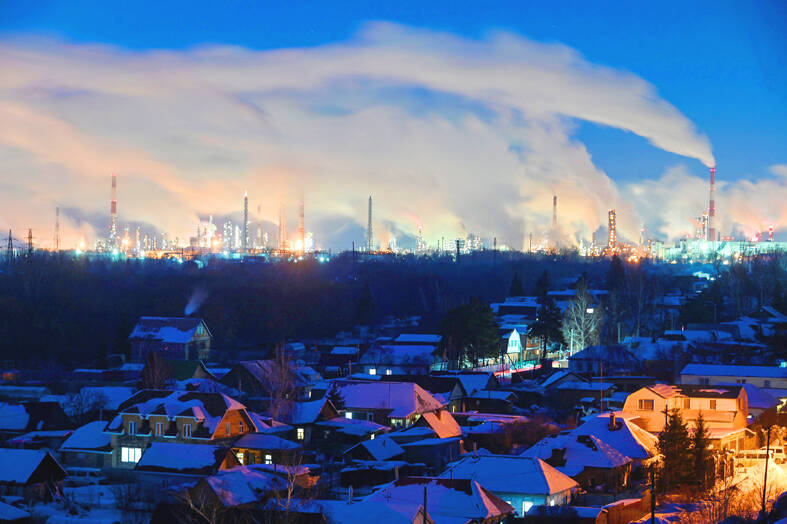Oil on Friday posted its largest weekly gain in four months after Russia followed through on a threat to cut production in response to Western energy sanctions.
Moscow said it would reduce output by 500,000 barrels, equivalent to about 5 percent of last month’s levels. The cut was the first major effect on Russian production from the swath of sanctions that have been placed on the country’s output, leading West Texas Intermediate for March delivery to advance 2.13 percent to US$79.72.
It was up 8.6 percent from the previous week’s US$73.39.

Photo: Reuters
Brent crude, the international benchmark, for March delivery rose 2.24 percent to US$86.39, gaining 8.1 percent from the previous week’s US$79.94.
This week’s rally also got a boost from Saudi Arabia’s decision to sell barrels at higher prices to Asian countries amid stronger demand from China, as well as supply disruptions in Turkey, Norway and Kazakhstan.
Russian Deputy Prime Minister Alexander Novak said the country’s production cut is voluntary and a response to Western price caps.
Still, analysts have been predicting some output losses following the recent sanctions announcements, TD Securities commodity strategy director Daniel Ghali said.
“It is possible that Russia is portraying these output losses as a decision to cut their oil production when they might have occurred regardless,” Ghali said.
Despite the cuts, Russia’s partners in the OPEC+ coalition signaled that they would not boost output to fill in for the reductions.
“Crude prices reacted positively to the news, considering that so far Russian oil production has been relatively resilient,” UBS Group AG analyst Giovanni Staunovo said.
“The move ... aims to improve oil revenues by narrowing the discount of Russian oil to Brent,” he said.
An EU-wide ban on Russian oil products — such as diesel, gasoline and jet fuel — came into effect on Sunday last week, alongside a G7 price cap on the same items.
That expanded on the EU embargo on seaborne oil deliveries introduced two months ago — when it also established with G7 partners a US$60 per barrel cap for Russian exports.
Oil, already bolstered by the reopening of top consumer China after lengthy COVID-19 pandemic restrictions, rebounded further on the news from Novak, who in charge of Moscow’s energy policy.
Russia is part of a 23-nation alliance with the OPEC crude cartel that already agreed in October to reduce output by 2 million barrels per day until the end of this year.
Additional reporting by staff reporter, with AFP

To many, Tatu City on the outskirts of Nairobi looks like a success. The first city entirely built by a private company to be operational in east Africa, with about 25,000 people living and working there, it accounts for about two-thirds of all foreign investment in Kenya. Its low-tax status has attracted more than 100 businesses including Heineken, coffee brand Dormans, and the biggest call-center and cold-chain transport firms in the region. However, to some local politicians, Tatu City has looked more like a target for extortion. A parade of governors have demanded land worth millions of dollars in exchange

Hong Kong authorities ramped up sales of the local dollar as the greenback’s slide threatened the foreign-exchange peg. The Hong Kong Monetary Authority (HKMA) sold a record HK$60.5 billion (US$7.8 billion) of the city’s currency, according to an alert sent on its Bloomberg page yesterday in Asia, after it tested the upper end of its trading band. That added to the HK$56.1 billion of sales versus the greenback since Friday. The rapid intervention signals efforts from the city’s authorities to limit the local currency’s moves within its HK$7.75 to HK$7.85 per US dollar trading band. Heavy sales of the local dollar by

Taiwan Semiconductor Manufacturing Co’s (TSMC, 台積電) revenue jumped 48 percent last month, underscoring how electronics firms scrambled to acquire essential components before global tariffs took effect. The main chipmaker for Apple Inc and Nvidia Corp reported monthly sales of NT$349.6 billion (US$11.6 billion). That compares with the average analysts’ estimate for a 38 percent rise in second-quarter revenue. US President Donald Trump’s trade war is prompting economists to retool GDP forecasts worldwide, casting doubt over the outlook for everything from iPhone demand to computing and datacenter construction. However, TSMC — a barometer for global tech spending given its central role in the

An Indonesian animated movie is smashing regional box office records and could be set for wider success as it prepares to open beyond the Southeast Asian archipelago’s silver screens. Jumbo — a film based on the adventures of main character, Don, a large orphaned Indonesian boy facing bullying at school — last month became the highest-grossing Southeast Asian animated film, raking in more than US$8 million. Released at the end of March to coincide with the Eid holidays after the Islamic fasting month of Ramadan, the movie has hit 8 million ticket sales, the third-highest in Indonesian cinema history, Film